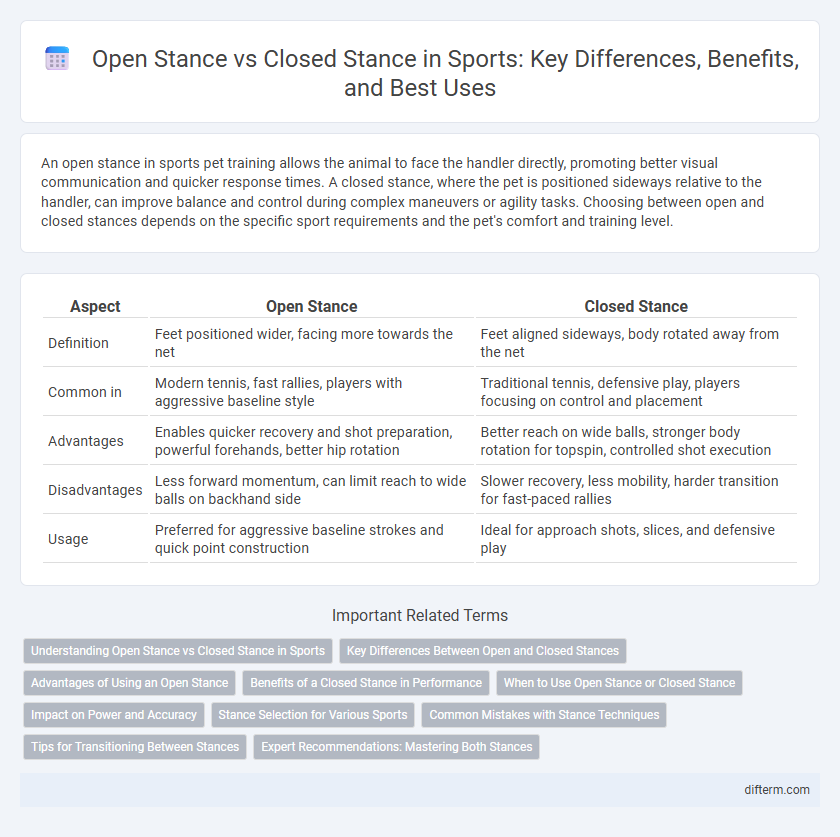An open stance in sports pet training allows the animal to face the handler directly, promoting better visual communication and quicker response times. A closed stance, where the pet is positioned sideways relative to the handler, can improve balance and control during complex maneuvers or agility tasks. Choosing between open and closed stances depends on the specific sport requirements and the pet's comfort and training level.
Table of Comparison
| Aspect | Open Stance | Closed Stance |
|---|---|---|
| Definition | Feet positioned wider, facing more towards the net | Feet aligned sideways, body rotated away from the net |
| Common in | Modern tennis, fast rallies, players with aggressive baseline style | Traditional tennis, defensive play, players focusing on control and placement |
| Advantages | Enables quicker recovery and shot preparation, powerful forehands, better hip rotation | Better reach on wide balls, stronger body rotation for topspin, controlled shot execution |
| Disadvantages | Less forward momentum, can limit reach to wide balls on backhand side | Slower recovery, less mobility, harder transition for fast-paced rallies |
| Usage | Preferred for aggressive baseline strokes and quick point construction | Ideal for approach shots, slices, and defensive play |
Understanding Open Stance vs Closed Stance in Sports
Open stance in sports refers to positioning where the athlete's feet point more towards the target, promoting greater hip rotation and increased power, commonly seen in tennis and golf. Closed stance involves aligning the feet and body more parallel to the baseline or target line, enhancing stability and control, frequently utilized in baseball batting and martial arts. Understanding the biomechanical advantages of each stance helps athletes optimize performance based on their sport-specific demands and personal technique.
Key Differences Between Open and Closed Stances
Open stance positions the feet wider apart and face the target more directly, enhancing balance and enabling quicker body rotation in sports like tennis and golf. Closed stance aligns the feet more parallel and typically angles them away from the target, promoting greater power and precision in movements such as baseball batting and boxing. The key differences lie in weight distribution and body alignment, which impact control, power, and range of motion during athletic performance.
Advantages of Using an Open Stance
Using an open stance in sports like tennis and golf enhances player mobility, allowing quicker recovery between shots. It promotes better balance and weight distribution, which improves power generation and shot accuracy. This stance also facilitates easier adjustment to varying ball positions and angles, optimizing overall performance.
Benefits of a Closed Stance in Performance
A closed stance in sports like golf and baseball enhances stability and power by promoting a stronger weight transfer and better rotational mechanics. Athletes using a closed stance often achieve increased accuracy and control due to improved body alignment and reduced lateral movement. These biomechanical advantages contribute to more consistent performance and optimized energy efficiency during critical moments.
When to Use Open Stance or Closed Stance
Open stance is ideal in sports like tennis or golf when a quick, powerful shot is needed, allowing better hip rotation and faster recovery. Closed stance suits precision shots or situations requiring balance and control, such as in baseball batting or basketball shooting. Choosing the appropriate stance depends on the sport's specific movement demands and the desired shot outcome.
Impact on Power and Accuracy
Open stance in sports like tennis and baseball enhances power by allowing greater hip rotation and weight transfer, generating more force during the swing or stroke. Closed stance improves accuracy by promoting a more stable base and better alignment with the target, facilitating precise control over the ball's direction. Choosing between open and closed stance depends on balancing the need for maximum power versus pinpoint accuracy in performance.
Stance Selection for Various Sports
Open stance offers greater rotational freedom and is preferred in sports like tennis and baseball for powerful swings, while closed stance provides stability and is favored in golf and boxing for controlled movements. Athletes select stance based on required balance, range of motion, and sport-specific techniques to optimize performance. Understanding biomechanical demands helps tailor stance choice, enhancing accuracy, power, and injury prevention across various sports disciplines.
Common Mistakes with Stance Techniques
Common mistakes with open stance and closed stance in sports include improper weight distribution, leading to reduced balance and power. Athletes often position their feet too narrowly or too wide, compromising stability and movement efficiency. Neglecting hip alignment further diminishes performance and increases injury risk during dynamic actions.
Tips for Transitioning Between Stances
Transitioning between open stance and closed stance requires gradual practice to build muscle memory and maintain balance during movement. Focus on foot placement by aligning the lead foot slightly open or closed relative to the target, which enhances control and shot accuracy. Incorporate drills that emphasize weight transfer from back foot to front foot while keeping the hips and shoulders oriented correctly for each stance style.
Expert Recommendations: Mastering Both Stances
Expert recommendations emphasize mastering both open and closed stances to enhance versatility and adaptability across different sports disciplines. Open stance offers greater mobility and quicker recovery, while closed stance provides stability and precision in shot execution. Training programs integrating drills for both stances improve overall performance by allowing athletes to switch seamlessly based on situational demands.
open stance vs closed stance Infographic

 difterm.com
difterm.com